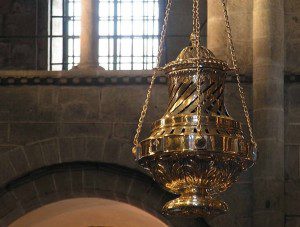
From Wikipedia: The Botafumeiro is the famous thurible found in the Santiago de Compostela Cathedra l (in the past similar devices were used in large churches in Galicia, nowadays sometimes is used in the Tui Cathedral). Incense is burned in this swinging metal container, or “incensory”. The name “Botafumeiro” means “smoke expeller” in Galician.
The Botafumeiro is carried and swung by eight men in red robes, called tiraboleiros. The term “tiraboleiro” is a Galician distortion of the Latin word “turifer”, which means “incense carrier”, and from which is derived the English equivalent, “thurifer”. This comes from the Latin words “thus”, meaning incense, and “fero”, meaning “carry”. There is a comparable term in Spanish, a “turiferario”.[12]
The current chief “tiraboleiro” is Armando Raposo.[13]
Botafumeiro pulley mechanism
In the 13th century, the pulley mechanism was changed to incorporate a set of coaxial drums of different diameters. Without this innovation, the largest excursion of the Botafumeiro would be about 1.5 meters, the length of the rope pulled by the tiraboleiros.
In the 15th century, France’s King Louis XI (1423–1483) donated money to the cathedral to replace their medieval thurible, which was made of silver. A new silver thurible was put into service in 1554. Unfortunately, this ornate vessel was stolen by Napoleon’s troops in April, 1809, during an episode in the Spanish War of Independence (1808–1814). Therefore, the Louis XI censer was replaced by the present less ostentatious Losada thurible in 1851.
After 155 years of use, the Botafumeiro was restored in early 2006 by artisans and craftsmen working under Luis Molina Acedo. They repaired the dents and cracks in the Botafumeiro and then reapplied a 20 micrometre thick plating of silver to the vessel.
Many other cathedrals had similar large thuribles at one time. However, most of the other
There have been a number of accidents that occurred during the swinging of the Botafumeiro over the years. Apparently at one time, the Botafumeiro was attached to the rope with a hook which sometimes became disconnected.
One of the most renowned accidents took place during a visit of Princess Catherine of Aragon. She was on a journey to marry the heir to the English throne in 1499 and stopped by the cathedral in Santiago de Compostela. While it was being swung, the Botafumeiro flew out of the cathedral through the Platerias high window. No one was reported to have been injured on this occasion.
The ropes and other devices securing the Botafumeiro have also failed on May 23, 1622, and more recently in 1925 and July 1937. In 1622, the Botafumeiro fell at the feet of the tiraboleiros. In July 1937, the cords holding the Botafumeiro failed again, and hot coals were spilled on the ground.
Current procedure is to attach the rope to the Botafumeiro with a set of “sailor’s knots”.[
[edit]Reported weight of the Botafumeiro
Almost every source reports a different weight of the Botafumeiro. This might be because there are multiple thuribles used in ceremonies at the cathedral, and different weights when the thuribles are empty and full of fuel. For example, one can find reported weights of
“I found it to be a great book; a fascinating, fast-paced thriller, written in a strong voice, filled with rich dialogue, complex and colorful characters, a story-line that tackles the most meaningful, religious and political subjects in the world. It is an impressive work…Move over Dan Brown, I was blown away!” – DANIEL KLIMEK -Scholar, seminarian and Marian expert featured in the full length motion picture – “Queen of Peace”












